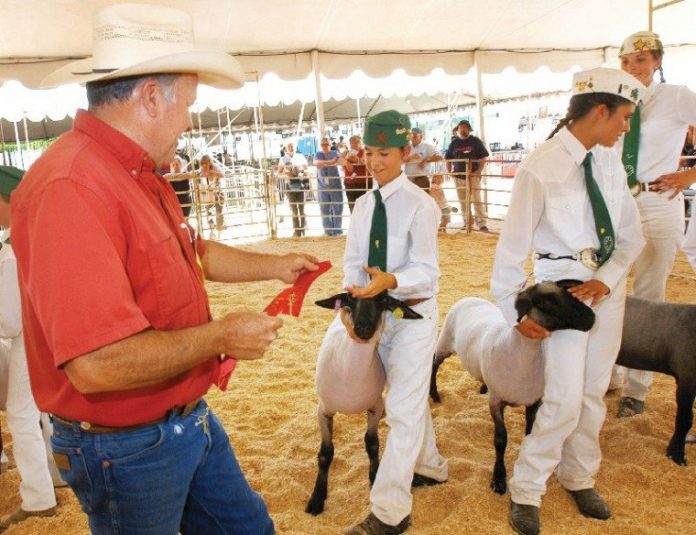Jiana Escobar gets excited this time of year, and it’s not only
because she knows how to raise a champion pig.
San Jose – Jiana Escobar gets excited this time of year, and it’s not only because she knows how to raise a champion pig.
For Escobar, who graduated from Gilroy High School in June, the Santa Clara County Fair is more like a homecoming than a cutthroat competition.
“It always feels like when it’s fair time, you’re going back to your family,” said Escobar, keeping an alert eye on her friends competing in the sheep competition Wednesday afternoon. “You’re seeing friends from your own (4-H) chapter and chapters from other cities … when one person loses, everyone is supportive.”
But the number of kids showing sheep, swine, goats, horses and a plethora of smaller animals has steadily declined over the past three decades. The fair itself has shrunk to a shadow of its former self. The remains of giant barns once used to house thousands of animals still sit on the landscape like a spooky reminder of the lost past, an ominous pile of ground-up concrete near the southwest corner of the fairgrounds.
“We’re struggling with this fair,” said Don Silacci, a member of the five-person Santa Clara County Fairgrounds Management Corporation’s board. “We’re trying to keep it going as long as we can … but there’s less kids in FFA (Future Farmers of America) and 4-H. It’s still a great opportunity for kids … you just look around the barn, and half these kids are helping others.”
This year organizers are desperately trying to reinvigorate the money-losing family event, investing in bigger rides and attractions and boosting ticket prices. But if the fair loses money again, as it has for the past 10 years, county supervisors may rethink its future.
Silacci, a longtime Gilroy rancher with 300 cows on 5,000 acres, said there’s still talk of moving the extravaganza to South County and making it more of rural event. He also said organizers are optimistically planning to extend the number of days the fair is open – this year’s event is five days long, ending Sunday, after shrinking to three days last year. Admission ticket prices have also gone up in an effort to boost revenue.
For parents and youngsters working hard to keep South County 4-H clubs alive, there’s still hope agricultural camaraderie will spread even as the region urbanizes.
“I think it’s a big strive for all of us to get ‘city kids’ and rural kids involved,” said Escobar, a member of the Gilroy-based Adams 4-H Club. While many of her friends’ parents did 4-H when they were growing up, she said the group is trying to appeal to a new generation of kids who don’t have ranching backgrounds.
“It’s part of the 4-H mission,” she said. “A lot of us don’t think about it, living in Silicon Valley, but the heart of California is in the pork, dairy and sheep industries. You don’t think about it in your daily life, but 99 percent of what you touch has a piece of agriculture in it, from the shirt you wear to the food you eat.”
This year, a dozen 4-H and five FFA chapters are bringing more than 1,000 large and small animals to the fair. Competitions began Monday with an auction scheduled Sunday. Organizers estimated the total number of kids participating to be more than 300, down significantly from the fair’s glory days. Outside of Morgan Hill and Gilroy, Campbell is the last city in the county with an FFA program for high school students. Sunnyvale’s 4-H barn remains in use, but is now surrounded by office buildings.
About 60 kids from Morgan Hill, San Martin and Gilroy joined the fun.
“I’ve been doing 4-H for 10 years, so I recognize a lot of familiar faces,” said Paulina Pinheiro, who just graduated from Live Oak High School in Morgan Hill. Pinheiro won first place in the market class division for sheep, as well as third place in “advanced showmanship,” where participants are judged for handling their animals.
Morgan Hill resident Joey Cassibba, who’s entering 9th grade at Sobrato High School this fall, won three ribbons in the various sheep competitions as well as five first-place awards in photography.
“It’s the best I’ve ever done,” Cassibba said, referring to the animal competition. “We had a good judge … he was friendly and he told you what you were doing right and wrong.”
Growing up in the countryside near Gilroy, Escobar had plenty of opportunities to raise pigs, chickens and sheep. This summer she’s traveling to three fairs, including the San Benito County Fair and the California State Fair. The most she’s been to in a summer is four.
On Tuesday, she took first place in the feeder division for her 124-pound “blue butt” pig, a Hampshire-Yorkshire cross. She also won first place for “advanced showmanship” that day.
“It’s a lot of hard work,” she said. “For three to four months, you’re feeding it, taking it on walks, if it gets sick you’re doctoring it … you’re spending two to three hours a day, depending on the number of pigs you own.”
But when its fair time, it all pays off, even though friendship trumps rivalry.
“It’s not a cutthroat competition,” said Gilroy resident Michael Spier, there to support Adams 4-H members, including his daughter Koyrn who was busy helping younger kids display their animals. “They’re all friends, they’re all supporting each other.”















